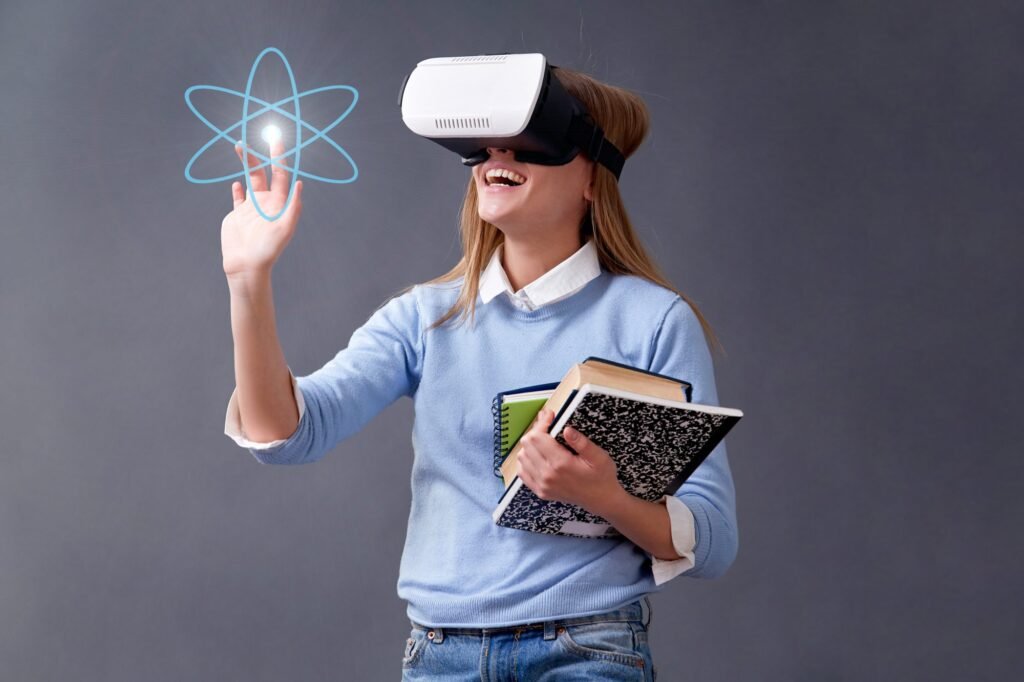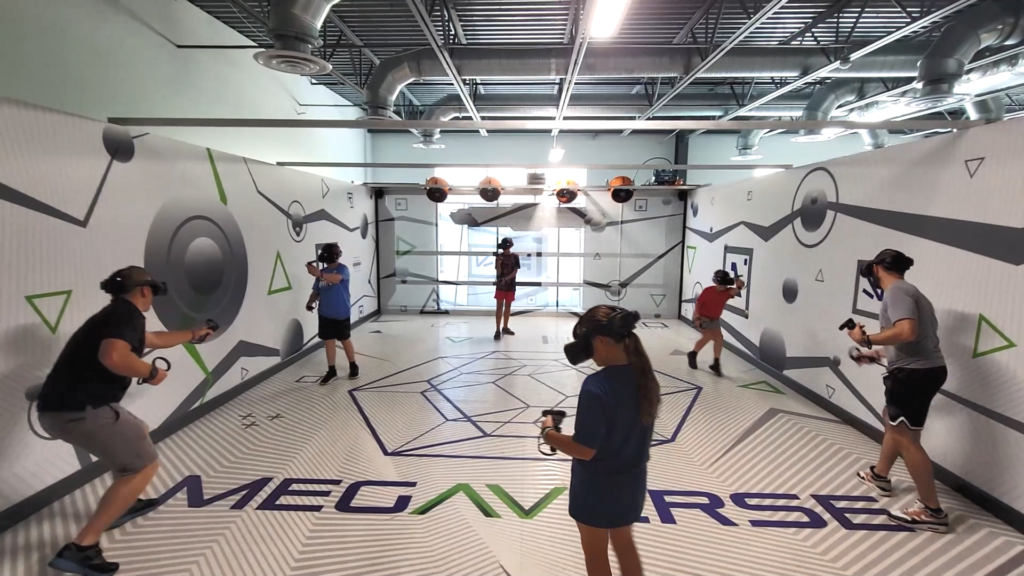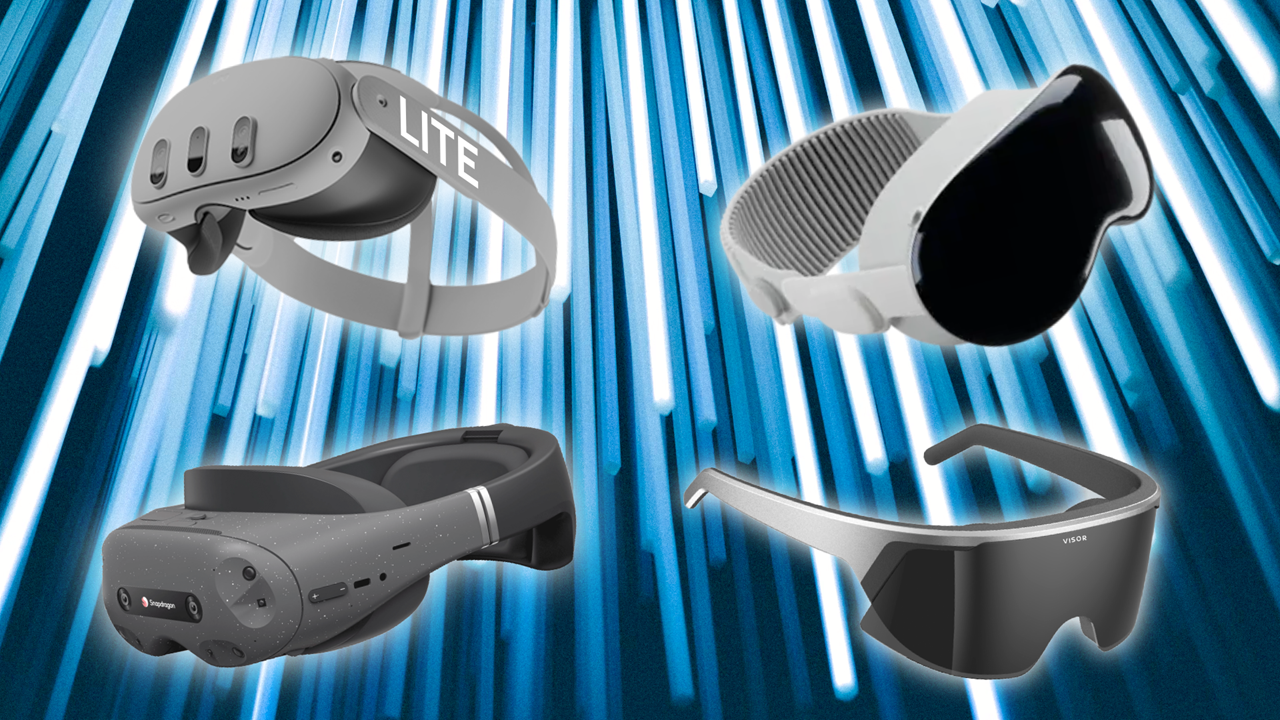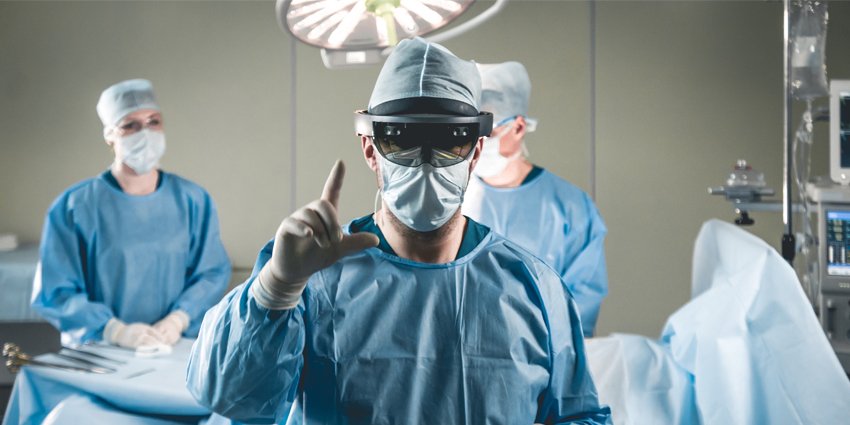By: Husam Yaghi and Tamara Yaghi
The year is 2024, and the XR stage is ablaze with activity. Augmented Reality (AR), Virtual Reality (VR), and everything in between, known collectively as XR, has finally shed its “cool-but-niche” label and exploded onto the mainstream stage.
The hardware revolution
We’re no longer tethered to clunky headsets and bulky controllers. Sleek, lightweight glasses and intuitive gloves blur the line between the physical and digital. Haptic feedback and spatial audio transport you into simulated worlds with unparalleled realism.

The game changers
- Meta Ray-Ban Glasses: Forget chunky headsets, these stylish sunglasses seamlessly integrate AR into your world. Imagine discreetly capturing photos and videos with voice commands, viewing directions overlaid on your environment as you walk, or translating foreign languages in real-time. Meta Ray-Ban glasses blend seamlessly with your daily life, blurring the lines between reality and digital augmentation.
- Apple Vision Pro: Step into a world of enhanced perception with Apple’s VR headset. Not just for immersive gaming, the Vision Pro boasts cutting-edge medical applications. Imagine surgeons overlaying real-time scans onto a patient’s body, architects stepping into blueprints brought to life, or students dissecting virtual frogs in biology class. The Vision Pro’s advanced displays and spatial audio create a near-photorealistic world, unlocking unprecedented possibilities in healthcare, education, and design.
- HTC XReal: Enter a next-gen VR experience with HTC’s innovative gloves. Gone are the days of clunky controllers, XReal immerses you with hand tracking so fluid and precise, it feels like an extension of your own body. Sculpt virtual worlds, manipulate complex machinery, or collaborate with colleagues across the globe – all with the unparalleled naturalness of your own hands. XReal redefines the way we interact with the virtual world, pushing the boundaries of human-computer interaction.
- TCL RayNeo X2: The TCL RayNeo X2 is a cutting-edge pair of binocular full-color micro-LED optical waveguide AR glasses which deliver stunningly crisp and vivid visuals along with real-time multi-language dialogue translation, smart navigation with SLAM system and gesture recognition, and a stylish design focused on comfort for everyday wear.
Expected goals and strategies of major players
Meta
- Ray-Ban Glasses: Social AR Domination: Imagine “Instagram Stories” in real-time AR, collaborative AR art projects, and shared virtual experiences layered onto real-world locations. Look for deeper integrations with Facebook and WhatsApp, creating virtual hangouts and immersive group activities.
- Affordable VR Expansion: A rumored “Quest Lite” headset could target budget-conscious consumers, potentially featuring mobile VR game streaming and simpler, social-focused experiences. This might even pave the way for VR fitness apps and casual workout routines.
- Project Cambria: Whispers of a high-end, standalone headset boasting advanced eye tracking and facial expression capture hint at Meta’s ambitions for next-generation VR experiences. Could this be the platform for groundbreaking social VR interactions and hyper-realistic avatar customization?
Apple
- Vision Pro: Medical Revolution: Partnerships with major hospitals and medical schools could showcase Vision Pro’s surgical training applications. Imagine surgeons practicing complex procedures on holographic models or collaborating remotely with specialists via shared VR simulations.
- Education Reimagined: Expect collaborations with universities and educational institutions to explore Vision Pro’s potential for immersive learning. Imagine students dissecting virtual frogs in biology class, experiencing historical events in first-person, or exploring the depths of the ocean in a virtual coral reef.
- Content Powerhouse: Don’t rule out exclusive partnerships with Hollywood studios or renowned artists. A mind-blowing VR film experience or an interactive art exhibit built within Vision Pro could further solidify Apple’s position as a content creator and curator in the XR space.
HTC
- Industrial Transformation: Partnerships with manufacturing giants and logistics companies will showcase XReal’s potential for remote assistance and training. Imagine technicians guiding robots with hand gestures, engineers manipulating complex machinery virtually, or new employees learning assembly lines through interactive holographic tutorials.
- Design Revolution: Collaborations with architecture and design studios could unlock XReal’s potential for intuitive 3D sculpting and modeling. Imagine architects shaping buildings with the fluidity of hand movements, designers crafting furniture in virtual space, or sculptors bringing their visions to life with unparalleled precision.
- Fitness Frontier: Exploring partnerships with fitness centers and rehabilitation clinics could introduce XReal-powered workout routines and physical therapy applications. Imagine personalized exercise programs guided by virtual trainers, rehabilitative exercises tailored to individual needs, or even virtual sports experiences that push the boundaries of physical training.
Microsoft
- Remote Assistance King: Partnerships with global companies and service providers could solidify HoloLens 3’s position in remote assistance. Imagine field technicians receiving real-time holographic guidance from experts miles away, surgeons collaborating on complex procedures across continents, or even firefighters.
Beyond the Big Leagues
- Magic Leap 2: Keep an eye out for the second iteration of Magic Leap’s headset, boasting its unique light field technology. This technology promises unparalleled visual fidelity and a more natural human-computer interaction experience compared to traditional screen-based displays.
- Valve Index Standalone: A standalone version of the acclaimed Valve Index headset could shake up the high-end VR market. Imagine enthusiasts enjoying the Index’s renowned performance and precision tracking without the tether to a powerful PC.
- Lynx and Pimax: These niche players cater to the simulation and enthusiast market. Lynx specializes in lightweight VR headsets ideal for flight simulation, while Pimax offers high-resolution, wide-field-of-view headsets for immersive racing and other demanding VR experiences.
- ByteDance: ByteDance, the parent company of TikTok, is making strategic moves in the XR space. They acquired Pico Interactive, a leading VR headset manufacturer in China, in 2022. Expect to see Pico headsets become more widely available and potentially integrated with ByteDance’s existing platforms like TikTok and Douyin, offering new social and entertainment experiences in VR.
- Samsung Infinite: Speculations suggest that “Infinite” could be a lightweight, comfortable pair of AR glasses with advanced displays and powerful processing capabilities. Samsung Infinite could challenge established players like Meta Ray-Ban Stories and Apple Vision Pro in the high-end AR market.
- Immersed Visor: Immersed Visor is a unique VR headset designed for fitness and physical training. Unlike traditional VR headsets that isolate users from their surroundings, Immersed Visor blends real and virtual worlds, allowing users to see their physical bodies and surrounding environment while exercising in VR. This hybrid approach combines the immersive training benefits of VR with the safety and awareness of the real world, making it ideal for fitness enthusiasts and professionals.

Practical Usecases:
Education:
- Imagine a student dissecting a virtual frog in biology class, not just looking at static images. The frog reacts to their actions, providing a visceral learning experience.
- History students could walk through virtual recreations of ancient Rome or experience the Battle of Gettysburg firsthand, gaining a deeper understanding of the past.
- Language learners could immerse themselves in virtual environments practicing conversational skills with native speakers, overcoming the limitations of traditional textbooks.
Healthcare:
- Surgeons could rehearse complex procedures on holographic models of a patient’s organ, minimizing risks and optimizing outcomes for real-world surgery.
- Physical therapists could guide patients through rehabilitation exercises in VR, providing personalized feedback and motivation with gamified experiences.
- Remote consultations could become commonplace, with doctors examining patients using AR overlays and real-time data analysis, regardless of their location.
Design and Engineering:
- Architects could walk through virtual models of their buildings, adjusting details and collaborating with clients in real-time before a single brick is laid.
- Mechanical engineers could manipulate intricate machinery in VR, troubleshooting potential issues and optimizing designs before physical prototypes are built.
- Fashion designers could create 3D virtual clothing models that customers can try on and customize through AR, transforming the retail experience.
Social Interaction and Entertainment:
- Friends and family could gather in shared virtual spaces, watching movies, playing games, or simply socializing, despite physical distance.
- Live concerts and sporting events could be experienced in VR with full surround sound and the feeling of being part of a massive crowd.
- Museums and art galleries could offer interactive virtual exhibits where visitors can explore artworks and interact with historical figures.
Beyond XR: The Future of Human-Computer Interaction
While XR takes center stage, other advancements in human-computer interaction are brewing in the background. Brain-computer interfaces (BCIs) hold the potential for direct control of devices and software with our thoughts. Imagine painting landscapes with your mind, composing music through neural impulses, or even controlling prosthetics with effortless precision.
Advances in haptics are also bringing a richer sense of touch to the digital world. Imagine feeling the texture of virtual objects, the force of wind in a VR game, or even the delicate touch of a loved one across the globe through haptic feedback technology.
The future of human-computer interaction is a symphony of cutting-edge technologies, merging the physical and digital realms in ways we can only begin to imagine. As XR paves the way for deeper immersion and interaction, prepare to be amazed by the boundless possibilities that lie ahead.

Exciting possibilities on the horizon:
The Rise of the “Mixed Metaverse”:
Imagine a world where the boundaries between the physical and virtual are completely permeable. We work, shop, and socialize in shared mixed-reality spaces, seamlessly transitioning between our real-world environments and virtual overlays. Virtual avatars become extensions of ourselves, reflecting our personalities and emotions with nuanced detail. This “Mixed Metaverse” could revolutionize social interaction, entertainment, and even our sense of personal identity.
XR Reshapes the Workforce:
XR training simulations will go beyond static scenarios, immersing workers in hyper-realistic simulations to hone their skills. Imagine surgeons practicing complex procedures on virtual patients, firefighters navigating smoke-filled buildings in VR, or astronauts training for spacewalks in simulated zero-gravity environments. This level of immersive training can enhance skill development, improve safety protocols, and ultimately, save lives.
Revolutionizing Design and Engineering:
Architects and engineers will create and manipulate blueprints in 3D, walking through virtual models of their designs before a single brick is laid. XR technology can empower designers to experiment with concepts, collaborate with clients in real-time, and ensure accuracy with unparalleled precision. Imagine sculpting buildings with intuitive hand gestures, visualizing intricate machinery in full scale, or exploring innovative city planning concepts within shared virtual spaces.
XR Transforms Healthcare:
Beyond surgical training, XR can provide patients with personalized therapies and rehabilitation programs. Imagine recovering from physical injuries through interactive VR games, managing chronic conditions with personalized virtual coaches, or even undergoing remote consultations with specialists located anywhere in the world. XR has the potential to democratize healthcare, making it more accessible and personalized than ever before.
Unleashing the Power of Creativity:
2024 is just the beginning of XR’s transformative journey. As the technology evolves and becomes more accessible, we can expect a wave of innovation that will reshape our world in ways we can only begin to imagine. From revolutionizing industries to redefining creativity and human interaction, the future of XR holds immense potential. Now is the time to embrace this emerging technology and ensure it’s harnessed for the benefit of all.

Call to Action:
Ready to experience the XR revolution firsthand? Explore the latest devices, apps, and experiences and become a part of the growing XR community.
Disclaimer: “This blog post was researched and written with the assistance of artificial intelligence tools.”


